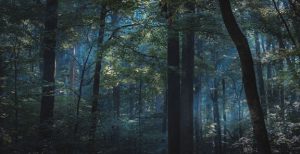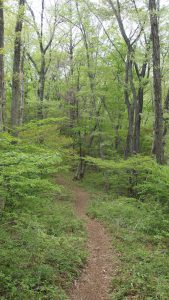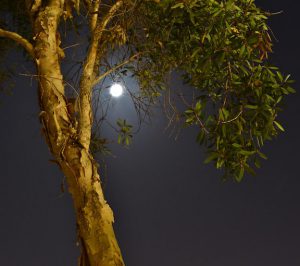All parts of this story are consolidated on one page here.
Beneath the Wild Forest’s thick canopy, the raging thunderstorm soon lost its force. Ina hadn’t yet taken five steps among the majestic old-growth trees before the pouring rain began to sound distant and muted. Even the lightning, bright as it was, barely reached into the forest’s dark depths. After a few more steps, Ina had left the storm far behind and could feel only the warm, humid night air. Her soaked dress seemed to be drying with unnatural speed. An occasional drop of rain still came through the trees, but by now Ina would never have known there was a storm going on if she hadn’t just walked through it.
(Creative Commons image via flickr)
The hovering ball of witch-fire stayed close to her now, illuminating a narrow path that had not been made by human feet. Every now and again there was a hoofprint in the soft ground; probably deer tracks, Ina thought, but she couldn’t see them clearly. Once she came upon pawprints that looked like a large dog’s—but no, it was much more likely they had been made by a wolf.
She found herself wondering, in a strangely detached, abstract way, how she could walk without fear here. Wolves roaming the forest, witches scheming to mysterious ends—surely, there was danger at every turn. And yet Ina knew, with a certainty that went beyond ordinary knowing, that she would come to no harm.
The path narrowed even farther as it began sloping downward. From the thick brush on either side, brambles caught at the hem of Ina’s dress. Water was flowing somewhere off to the right, and Ina thought at first that the path might be leading her back out of the forest, into the storm. Then, as she turned another bend, the witch-fire illuminated a fast-rising brook that was very near to overflowing its banks.
Twisting away to the left, the path began to rise out of the valley, winding its way toward a rocky hillside where lights flickered softly. As she came closer, Ina could see that they were not simply candles or torches but had magical origins, just like the fire that had been her guide.
Four teenage girls were standing near the base of a cliff. A bright swarm of fireflies hovered around the nearest girl, who was short and had freckles and red hair. A taller, dark-skinned girl with cascading black curls was surrounded by a cloud of luminescent moths in bluish-purple hues. Another girl with straight dark hair and broad cheekbones stood next to a large bird whose feathers glowed like fiery embers; it perched atop a granite bounder and had the fierce beak of a hawk or eagle. Rounding out the group was a dark-eyed girl whose hair could not be seen beneath the heavy hood of her cloak, the fabric of which was thickly coated with multicolored patches of gleaming moss.
All of them turned to face Ina as she approached, and the tall girl with the cloud of moths gave her a tentative smile. Nobody spoke, though, and Ina decided she’d better introduce herself and try to find out what was going on here.
“Hi, my name is Ina.” She gave her new acquaintances the friendliest smile she could muster. “Ina Drim. I came from the lake, just a few minutes ago, after the thunderstorm started.”
Instead of giving introductions in return, the girls just stood there looking perplexed. Finally, the red-haired girl spoke in a hesitant tone.
“I am—well, I guess you can call me Firefly. I’m not sure what other name I might have. I’ve been in the forest all day, I think. Maybe.”
The other girls now looked even more confused. The girl standing next to the fiery bird shook her head wearily, as if giving up on the whole idea of speech. Then, as if responding to a signal that no human could hear, the bird broke the silence by cawing once, loudly.
A scraping sound came from the cliff face as a door set into the rocks, which had been invisible until now, began to slide open. It revealed a wide passage, well lit with torches on each side, in which a middle-aged woman stood with arms outstretched in greeting. She wore a black cloak and a wide-brimmed hat—not quite pointed, but close to it. Graying hair tumbled over her shoulders.
“Welcome, my dears. We have been joyfully waiting for you.”








